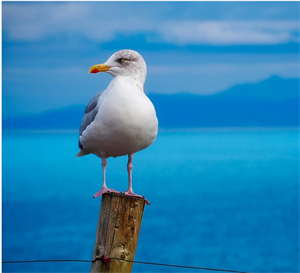PDF chapter test TRY NOW
The young seagull was alone on his ledge. His two brothers and his sister had already flown away the day before. He had been afraid to fly with them. Somehow, when he had taken a little run forward to the brink of the ledge and attempted to flap his wings, he became afraid. The great expanse of sea stretched down beneath, and it was such a long way down – miles down. He felt certain that his wings would never support him; so he bent his head and ran away back to the little hole under the ledge where he slept at night.
Explanation:
"Extreme fear can neither fight nor fly" is a quote by Shakespeare that depicts the situation in the lesson 'His First Flight'. But the quote is not to belittle the emotion called fear but serves as a reminder that extreme fear can hinder one's growth. The lesson revolves around a young seagull who is scared to fly as he has not been exposed to it yet. The lesson shows that fear can destroy us, but at the same time, if triggered in a positive way, it can also make us.

A little seagull
The lesson begins in the midst of the events that have already unfolded. It depicts a young seagull standing alone on the corner of a cliff. If a person jumps out of the cliff without any proper equipment, like a parachute or rope, there is a chance of getting hurt badly. The seagull is a little one and is very similar to a person who does not possess the gift of flying. Just because it is a bird, it does not start flying the minute it gets hatched. Birds lay eggs and hatch them in their nests. Once they hatch, the little ones grow up and learn to fly. But this process may not be as easier as it sounds. Just like a child learns to crawl, it is a long process. There is a chance that children might fall into this process. They initially crawl and then learn to stand up with support and then walk. Similarly, birds, when they feel ready to fly, they start flapping their wings and flying around. They initially do not fly for hours together as fledglings need time to get used to it. Birds have hollow bones that help them in flying.
The seagull feels bad as all its brothers and sisters have already flown away without any fear. The worst kind of fear arises when we see that every other person has moved ahead in life or has achieved the one thing that we have been struggling to do. That makes one feel left out. The seagull had not flown along with its siblings. It had tried its best as it ran from one end of the cliff to the corner and tried to flap its wings and fly. But once it saw that below the cliff it was an abyss of ocean, it was scared of the consequences of falling down. The sea stretched below it and it looked like it was a long way, miles down. The seagull was scared of the possibility of hurting itself and ran back quickly to the hole in the other edge of the ledge, where it usually slept at night. Often times, we do not act on certain things not because of the intensity or the difficulty of the task, rather it is because of focussing on the outcome or the consequences. The little seagull got scared by looking at the possibility of what might happen if he did not fly high and dropped down.

End of a cliff
Meaning of difficult words:
| S.No | Words | Meaning |
1 | Seagull | A bird that lives near the sea |
2 | Ledge | A narrow piece of rock that sticks out a cliff |
3 | Flap | To move up and down |
4 | Fledgling | A young bird whose wings have not developed fully |
5 | Abyss | A deep hole with no end |
6 | Brink | In the edge of a situation |
Reference:
National Council of Educational Research and Training (2006). Beehive. The First Flight - Liam O'Flaherty (pp. 32-36). Published at the Publication Division by the Secretary, National Council of Educational Research and Training, Sri Aurobindo Marg, New Delhi.
